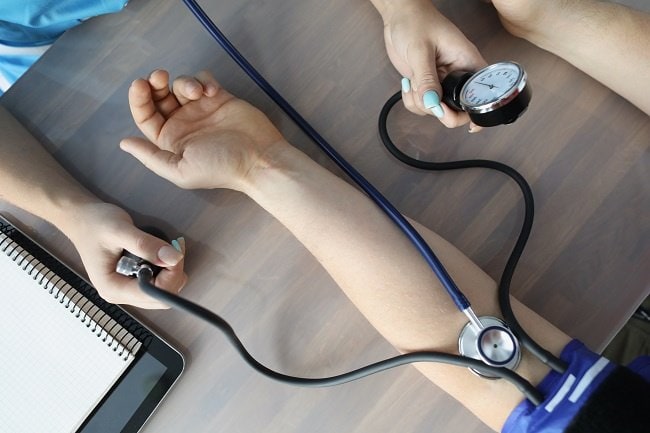How To Encourage Hypertension Screening In At-Risk Populations?

Hypertension, commonly known as high blood pressure, is a significant public health concern worldwide, particularly among at-risk populations. Early detection and regular screening are crucial in preventing the complications associated with hypertension, such as stroke, heart disease, and kidney failure.
Encouraging at-risk individuals to undergo hypertension screening requires a multifaceted approach that addresses barriers to access, raises awareness, and promotes the importance of regular screening. This article aims to present evidence-based strategies for promoting hypertension screening in at-risk populations.
The strategies discussed include:
- Raising awareness about hypertension and its risks
- Providing education on the importance of regular screening
- Collaborating with healthcare providers and community organizations
- Offering convenient and accessible screening options
- Implementing outreach programs in at-risk communities
- Utilizing technology and telemedicine for remote screening
- Providing incentives and rewards for screening participation
- Continuously evaluating and improving screening initiatives.
By implementing these strategies, healthcare systems and policymakers can effectively increase hypertension screening rates in at-risk populations and reduce the burden of hypertension-related complications.
Key Takeaways
- Rewarding individuals for participating in screening increases engagement and motivation.
- Incentive programs and rewards can encourage at-risk populations to undergo hypertension screening.
- Tangible rewards (monetary rewards, gift cards, health-related benefits) increase perceived value.
- Continuous evaluation enhances effectiveness and efficiency.
Raise Awareness about Hypertension and its Risks
Raising awareness about the prevalence of hypertension and its associated risks is crucial in order to effectively encourage hypertension screening in at-risk populations. Public campaigns play a significant role in disseminating information and educating individuals about the importance of regular blood pressure monitoring. These campaigns can utilize various platforms such as television, radio, social media, and community events to reach a wide audience.
By emphasizing the potential consequences of untreated hypertension, such as heart disease and stroke, these campaigns can motivate individuals to seek hypertension screening. Additionally, mobile clinics can be instrumental in providing convenient access to screening services, particularly in underserved areas. These clinics can travel to different locations, including community centers, workplaces, and schools, making it easier for individuals to undergo screening without the need for transportation or additional appointments.
By implementing these strategies, awareness about hypertension and its risks can be effectively raised, leading to improved screening rates in at-risk populations.
Provide Education on the Importance of Regular Screening
Promoting awareness of the significance of routine monitoring can contribute to increasing the likelihood of early detection and management of high blood pressure in vulnerable individuals.
Education plays a crucial role in this effort by providing knowledge about the benefits of regular screening.
By implementing targeted awareness campaigns, at-risk populations can become informed about the importance of hypertension screening.
These campaigns can include educational materials and resources that highlight the potential risks associated with untreated high blood pressure.
Additionally, providing information on the benefits of early detection and management can empower individuals to take proactive steps towards their health.
By emphasizing the potential consequences of untreated hypertension and the potential benefits of regular screening, education can motivate individuals to prioritize their cardiovascular health and seek appropriate medical attention.
Collaborate with Healthcare Providers and Community Organizations
Collaborating with healthcare providers and community organizations fosters a comprehensive approach to addressing the issue of undetected high blood pressure.
By establishing partnerships with healthcare providers, such as primary care physicians and specialists, a coordinated effort can be made to increase hypertension screening rates in at-risk populations. These providers play a crucial role in identifying individuals who may be at risk for high blood pressure and ensuring that appropriate screening measures are taken.
Additionally, community organizations can serve as valuable allies in reaching out to at-risk populations and engaging stakeholders. These organizations often have existing relationships and trust within the community, which can help to overcome barriers to screening, such as lack of awareness or access to healthcare services.
By working together, healthcare providers and community organizations can enhance the reach and impact of hypertension screening initiatives, ultimately leading to improved detection and management of high blood pressure.
Offer Convenient and Accessible Screening Options
To enhance the effectiveness of efforts to detect undiagnosed high blood pressure, it is crucial to provide easily accessible and convenient screening options for individuals who may be at risk.
One strategy to achieve this is to utilize mobile clinics that can reach underserved communities and provide on-site screening services. These mobile clinics can be equipped with the necessary equipment and trained healthcare professionals to conduct blood pressure measurements and provide immediate results.
Additionally, community partnerships can play a vital role in increasing the accessibility of hypertension screening. Collaborating with community organizations and healthcare providers can help identify locations where mobile clinics can be stationed, ensuring that individuals from at-risk populations have easy access to screenings.
By offering convenient and accessible screening options through mobile clinics and community partnerships, the likelihood of detecting undiagnosed high blood pressure in at-risk populations can be significantly improved.
Implement Outreach Programs in At-Risk Communities
An effective approach to raising awareness and identifying undiagnosed high blood pressure involves the implementation of outreach programs in communities at higher risk. These programs aim to engage individuals who may not have access to or may not prioritize regular healthcare screenings. By bringing hypertension screening services directly to these communities, barriers such as transportation, cost, and lack of awareness can be minimized. Community partnerships play a crucial role in the success of these outreach programs. Collaborating with local organizations and community leaders helps to establish trust and credibility, making individuals more likely to participate in the screenings. Additionally, culturally sensitive interventions are essential to ensure that the outreach programs are tailored to the specific needs and preferences of the at-risk populations. This may include providing materials in different languages, incorporating cultural practices, and addressing cultural beliefs and misconceptions surrounding hypertension. By implementing outreach programs that prioritize community partnerships and culturally sensitive interventions, more individuals in at-risk populations can be reached and encouraged to undergo hypertension screening.
| Pros | Cons |
|---|---|
| Increased access to screening services | Limited resources for implementation |
| Builds trust and credibility | Potential cultural barriers |
| Tailored interventions | Limited reach in remote areas |
| Raises awareness | Difficulty in sustaining programs |
| Identifies undiagnosed cases | Limited follow-up and treatment |
Utilize Technology and Telemedicine for Remote Screening
To further enhance the reach of hypertension screening initiatives, it is crucial to embrace the potential of technology and telemedicine. Implementing remote screening methods can overcome barriers such as distance and limited healthcare access in at-risk populations.
Remote monitoring devices can be utilized to track blood pressure readings, allowing healthcare providers to monitor patients’ blood pressure levels regularly. This technology enables timely interventions and adjustments to treatment plans, potentially reducing the risk of complications associated with hypertension.
Moreover, virtual consultations can be conducted to provide education and support to individuals at risk of developing hypertension. With the availability of telemedicine platforms, healthcare professionals can remotely assess patients, offer guidance on lifestyle modifications, and ensure medication compliance.
By incorporating technology and telemedicine into hypertension screening, at-risk populations can benefit from improved accessibility, timely interventions, and continuous support.
Provide Incentives and Rewards for Screening Participation
Incentivizing and rewarding individuals for their participation in screening initiatives can foster increased engagement and motivation, ultimately leading to greater awareness and early detection of hypertension. Implementing incentive programs and rewards programs can be an effective strategy to encourage at-risk populations to undergo hypertension screening.
These programs can offer various incentives such as monetary rewards, gift cards, or health-related benefits to individuals who participate in screening activities. By providing tangible rewards, individuals are more likely to perceive the value of participating in screening and are motivated to take part in such initiatives.
Additionally, rewards programs can be designed to provide ongoing incentives for individuals who consistently engage in screening, further reinforcing the importance of regular hypertension monitoring. These programs can not only encourage at-risk populations to prioritize their health but also contribute to reducing the overall burden of hypertension-related complications.
Continuously Evaluate and Improve Screening Initiatives
In order to enhance the effectiveness and efficiency of screening initiatives, it is crucial to continuously evaluate and improve the strategies employed. Evaluation methods play a vital role in assessing the impact of hypertension screening programs and identifying areas for improvement.
Various evaluation methods, such as surveys, interviews, and data analysis, can be utilized to gather information on the participants’ experiences and perceptions of the screening process. These methods can also help in tracking progress by measuring the number of individuals screened, identifying barriers to participation, and evaluating the overall success of the initiatives.
Regular evaluation allows for the identification of gaps and challenges in the screening process, enabling healthcare providers to make necessary adjustments and improvements. By continuously evaluating and refining screening initiatives, healthcare professionals can ensure that at-risk populations receive optimal care and support in managing their hypertension.
Frequently Asked Questions
What are the specific risks associated with hypertension in at-risk populations?
Specific risks associated with hypertension in at-risk populations include increased likelihood of cardiovascular diseases, kidney damage, and stroke. Barriers to prevention strategies include lack of awareness, limited access to healthcare, and non-adherence to medication and lifestyle modifications.
How can healthcare providers be encouraged to promote hypertension screening to their patients?
Healthcare provider engagement and patient education are crucial in promoting hypertension screening. Implementing educational programs, providing resources and guidelines, and offering incentives can encourage healthcare providers to prioritize and promote hypertension screening to their patients.
What are some examples of successful outreach programs that have been implemented in at-risk communities?
Successful outreach programs in at-risk communities have utilized community engagement strategies and health education initiatives. These programs aim to raise awareness about hypertension, provide accessible screening services, and empower individuals to take control of their health.
How can technology and telemedicine be effectively utilized for remote hypertension screening?
Technology advancements in telemedicine have enabled remote monitoring of hypertension. This approach overcomes barriers of access and allows for efficient screening in at-risk populations. Telemedicine can provide accurate and timely assessment, facilitating early detection and intervention.
What are some examples of incentives and rewards that have been proven to increase screening participation in at-risk populations?
Incentive programs and behavioral interventions have been shown to increase screening participation in at-risk populations. Examples include providing financial rewards, offering educational materials or resources, and implementing reminder systems to increase awareness and motivation for hypertension screening.









